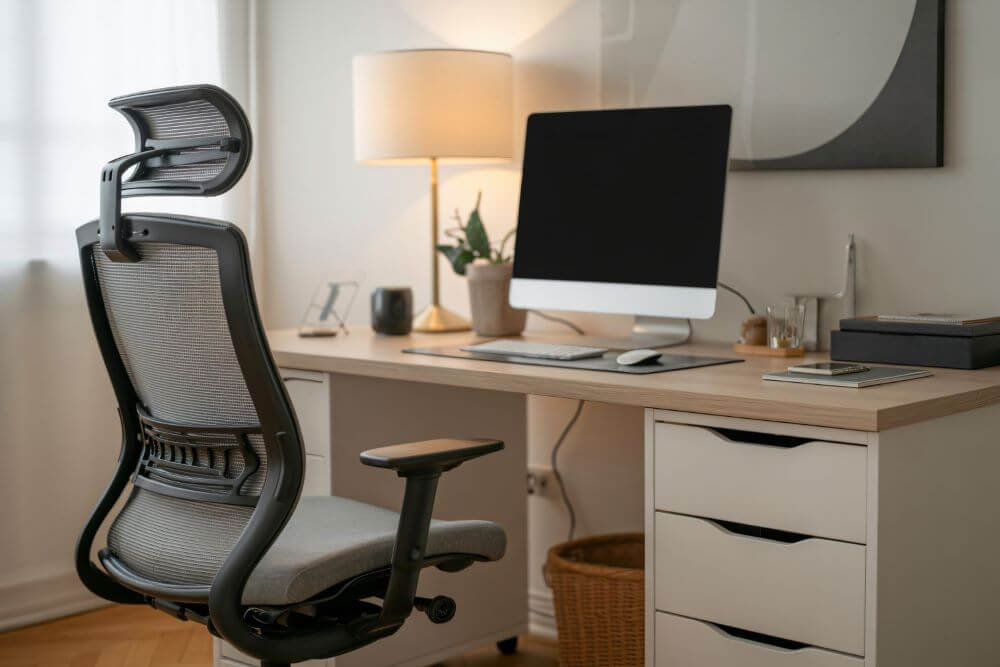The transition to a remote or hybrid work model has become a permanent feature of the modern professional landscape. While flexibility is a significant benefit, creating an environment that fosters productivity, focus, and well-being requires intentional effort. A successful work-from-home setup involves designing a space and routine that mirrors the structure of a traditional office setup while leveraging the advantages of being at home.
Distractions, from household chores to the allure of the television, can easily disrupt workflow. Furthermore, the lines between professional and personal life can blur, leading to burnout. Implementing strategic measures to define your organized workspace and time is crucial for long-term success and job satisfaction.
Read on to learn seven tips for a productive work from home setup.
1. Designate a Dedicated Workspace
The most fundamental step is to establish a physical boundary for work. This doesn’t necessarily require a spare room, but it should be a specific area used exclusively for professional activities. A dedicated space can signal to the brain that it’s time for focus and help household members understand when interruptions should be minimised. The ideal setup includes a proper desk and an ergonomic chair to support posture during long hours. Good lighting, preferably natural, can help reduce eye strain and boost mood.
Personalising the area with plants or art can also make it more inviting, but clutter should be kept to a minimum to maintain a clear mind. However, if you’re concerned about the energy costs of heating or cooling a home office throughout the day, it’s advisable to check your eligibility for ECO4 and similar options, as government schemes may offer assistance for energy-efficient improvements.
2. Invest in Ergonomics and Technology
Productivity is directly linked to comfort and functionality. An ergonomic investment is an investment in your health. A quality chair that supports the lumbar region and allows feet to rest flat on the floor is essential. The monitor should be at eye level to prevent neck strain, and a separate keyboard and mouse can improve wrist posture.
Reliable technology forms the backbone of remote work. A strong, stable internet connection is non-negotiable. It’s important to consider a mesh Wi-Fi system if your home office is far from the router. Necessary equipment may include a high-quality webcam and headset for clear communication during video conferences. These tools can help prevent technical difficulties from hampering efficiency and professional presence.
3. Establish a Consistent Routine
Structure is the antidote to the fluidity of working from home. A consistent routine can mimic the commute by providing a clear start and end to the workday. This can include waking up at the same time each morning, getting dressed in work-appropriate attire, and taking a morning walk to simulate a commute. Setting specific work hours and communicating them to colleagues and family can also help manage expectations.
Starting the day by prioritising tasks can provide direction and a sense of accomplishment as items are checked off the list. Just as important is the end-of-day ritual. Shutting down the computer, tidying the desk, and engaging in a relaxing activity can formally close the work period, preventing the tendency to work late into the evening.
4. Set Clear Boundaries with Housemates and Family
Communicating boundaries is critical for uninterrupted work time if you’re sharing your living space. This involves conversing with family members or housemates about work schedules and the importance of minimising distractions during focus hours. A visual signal, such as a closed door or a designated sign, can indicate when you shouldn’t be disturbed unless necessary.
If you’re a parent, coordinating schedules with a partner or planning quiet activities for children during essential calls can be helpful. Setting these boundaries respectfully but firmly can ensure that work responsibilities are met without causing friction at home.
5. Prioritise Movement and Breaks
In an office, natural breaks occur through walking to meetings or chatting with colleagues. At home, it’s easy to remain sedentary for hours. Intentionally scheduling breaks is vital for physical and mental health. For instance, using the Pomodoro Technique can be a good idea. It involves working in focused 25-minute intervals followed by a 5-minute break, which can be highly effective. During these breaks, stepping away from the screen is beneficial by stretching, walking around, grabbing a glass of water, or looking outside.
A proper lunch break away from the desk is also essential. Regular movement can boost circulation, reduce the risk of musculoskeletal issues, and improve concentration upon returning to work.
6. Leverage Digital Tools for Organisation
Technology offers a suite of tools designed to enhance productivity and collaboration. Project management platforms can help teams track progress and deadlines. Communication tools can facilitate quick queries without the formality of email, while scheduled video calls can maintain team cohesion.
Individually, calendar applications should be used diligently to block time for deep work, meetings, and breaks. Effectively utilising these tools can create a seamless workflow and ensure that nothing falls through the cracks, even when team members are miles apart.
7. Cultivate a Healthy Work-Life Balance
A productive work-from-home setup aims to support a sustainable and healthy balance. This means being disciplined about logging off at the end of the day and resisting the urge to check emails constantly. Creating physical and temporal separation between work and personal life allows for genuine rest and recuperation. Engaging in hobbies, spending quality time with family, and disconnecting from digital devices after hours are all crucial for preventing burnout. A productive remote worker works effectively during designated hours and fully enjoys their personal time thereafter.
Conclusion
Ultimately, a productive home office setup isn’t achieved by accident but through deliberate design and consistent habits. By keeping the information mentioned above in mind, you can maintain efficiency and stay connected with your teams. The cumulative effect of these strategies is preserving a healthy work-life balance, which is the true hallmark of sustainable remote work.

















